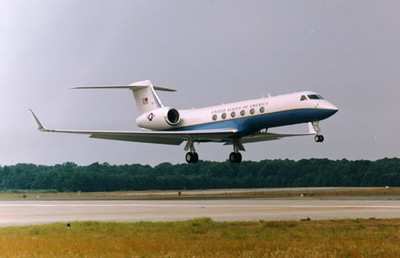C-37A Arrived At Ramstein Air Base December 7
Members of the 76th Airlift Squadron at Ramstein Air Base in
Germany received a C-37A Dec. 7 to help increase the flying
capabilities of the distinguished visitor mission. The new aircraft
is the military version of the Gulfstream V business aircraft, and
is the first C-37A to be stationed at Ramstein.

C-37A At Ramstein Air Base
The C-37A beddown program culminated with the aircraft arriving
Dec. 7 from the Gulfstream Service Center in Savannah, Georgia. "It
has been a busy year for our squadron, and we are honored to have
been chosen to receive the aircraft and have our own crew fly it
in," said Lt. Col. Tony Schenk, the 76th AS commander.
The squadron is the largest and most diverse operational support
aircraft squadron in the Air Force, and the C-37A will enable them
to excel with the high operations tempo they encounter here, said
Lt. Col. Tom Dowdle, the 76th AS standards and evaluations chief.
"It greatly expands our capabilities for (distinguished visitor)
travel," Colonel Dowdle said. "We currently cannot meet the demand
with our aircraft inventory, and this new addition will be a great
help."

C-37A File Photo
The C-37A is operated by a five-person crew and offers unrivaled
range, speed and communication capability, officials. It can fly as
high as 51,000 feet, has a maximum speed of Mach 0.885 and has a
range of 6,000 miles. "Our government and military's senior leaders
can fly non-stop from Ramstein (Air Base, Germany) to San
Francisco, Stuttgart (Germany) to Johannesburg, or Frankfurt to
Beijing," Colonel Dowdle said.
While airborne, a communication system operator will be able to
ensure DVs stay connected with everything going on throughout the
flight. With high-tech broadband capability, key decision makers
never lose contact with their chain of command. "The aircraft
offers a communication suite for (distinguished visitors) that will
allow them to be reachable at any time," Colonel Schenk said.
"Essentially, this offers everything they would have in their
office - while airborne."
Aside from the upgraded communication systems and increased
range, the aircraft also has an enhanced vision system that
enhances the pilots' effectiveness in flight. "EVS allows the pilot
to 'see' through the clouds," Colonel Dowdle said. "The infrared
image captured by the EVS is displayed on a head-up display, so the
pilot can see both the flight instruments and the EVS picture
simultaneously. With these two technologies, the C-37A can safely
operate in much lower visibility conditions than nearly any other
Air Force aircraft."
With the addition of the new aircraft comes the need to train
crew members. The simulator training, which is conducted in
Georgia, lasts approximately one month. Upon return, crewmembers
then finish their training in the aircraft. "Unlike most squadrons
that are transitioning to a new aircraft, our unit is also
deployed," Colonel Schenk said. "It's been challenging to
simultaneously deploy and train our aircrew for the C-37A. It's a
testament to the resolve and commitment of the men and women of the
76th (AS) that we have succeeded in both endeavors."
 ANN's Daily Aero-Term (12.04.25): Cooperative Surveillance
ANN's Daily Aero-Term (12.04.25): Cooperative Surveillance ANN's Daily Aero-Linx (12.04.25)
ANN's Daily Aero-Linx (12.04.25) NTSB Prelim: Extra Flugzeugproduktions EA 300/SC
NTSB Prelim: Extra Flugzeugproduktions EA 300/SC Classic Aero-TV: The Bally Bomber - The All Time Ultimate Warbird Replica?
Classic Aero-TV: The Bally Bomber - The All Time Ultimate Warbird Replica? ANN's Daily Aero-Linx (12.05.25)
ANN's Daily Aero-Linx (12.05.25)




